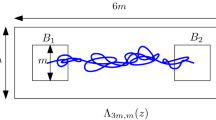Abstract
We study the pioneer points of the simple random walk on the uniform infinite planar quadrangulation (UIPQ) using an adaptation of the peeling procedure of Angel (Geom Funct Anal 13:935–974, 2003) to the quadrangulation case. Our main result is that, up to polylogarithmic factors, n 3 pioneer points have been discovered before the walk exits the ball of radius n in the UIPQ. As a result we verify the KPZ relation Knizhnik et al. (Modern Phys Lett A 3:819–826, 1988) in the particular case of the pioneer exponent and prove that the walk is subdiffusive with exponent less than 1/3. Along the way, new geometric controls on the UIPQ are established.
Similar content being viewed by others
References
J. Ambjørn, B. Durhuus, and T. Jonsson. A statistical field theory approach. Quantum geometry. Cambridge Monographs on Mathematical Physics. Cambridge University Press, Cambridge (1997).
O. Angel. Scaling of percolation on infinite planar maps, i. arXiv:0501006.
Angel O (2003) Growth and percolation on the uniform infinite planar triangulation. Geom. Funct. Anal., 13: 935–974
O. Angel and N. Curien. Percolations on infinite random maps (2013, In preparation).
Angel O., Schramm O (2003) Uniform infinite planar triangulation. Comm. Math. Phys. 241: 191–213
M. T. Barlow. Which values of the volume growth and escape time exponent are possible for a graph? Rev. Mat. Iberoamericana, 20 (2004), 1–31.
M. T. Barlow and T. Kumagai. Random walk on the incipient infinite cluster on trees. Illinois J. Math., 50 (2006), 33–65 (electronic).
I. Benjamini. Random planar metrics. Proceedings of the ICM (2010).
I. Benjamini and N. Curien. Ergodic theory on stationary random graphs, arXiv:1011.2526.
I. Benjamini and P. Papasoglu. Growth and isoperimetric profile of planar graphs. Proc. Amer. Math. Soc., 139 (2011), 4105–4111.
I. Benjamini and O. Schramm. Recurrence of distributional limits of finite planar graphs. Electron. J. Probab., 6 (2001), 23, (13, pp. electronic).
J. Bertoin. Random Fragmentations and Coagulation Processes. Cambridge Studies in Advanced Mathematics, Vol. vol. 102. Cambridge University Press, Cambridge (2006).
A. A. Borovkov and K. A. Borovkov. Asymptotic analysis of random walks. Encyclopedia of Mathematics and its Applications, Vol. 118. Cambridge University Press, Cambridge (2008). (Heavy-tailed distributions, Translated from the Russian by O. B. Borovkova).
J. Bouttier and E. Guitter. Distance statistics in quadrangulations with a boundary, or with a self-avoiding loop. J. Phys. A, 42 (2009), 465208.
A. K. Chandra, P. Raghavan, W. L. Ruzzo, R. Smolensky and P. Tiwari. The electrical resistance of a graph captures its commute and cover times. Comput. Complexity, 6 (1996/1997), 312–340.
P. Chassaing and B. Durhuus. Local limit of labeled trees and expected volume growth in a random quadrangulation. Ann. Probab., 34 (2006), 879–917.
D. Croydon and T. Kumagai. Random walks on Galton–Watson trees with infinite variance offspring distribution conditioned to survive. Electron. J. Probab., (51)13 (2008), 1419–1441.
N. Curien, L. Ménard, and G. Miermont. A view from infinity of the uniform infinite planar quadrangulation. arXiv:1201.1052.
N. Curien and G. Miermont. Uniform infinite planar quadrangulations with a boundary. arXiv:1202.5452.
P. G. De Gennes. La percolation : un concept unificateur. La Recherche, 7 (1976), 919–927.
B. Duplantier. Conformal random geometry. In: Mathematical statistical physics. Elsevier B. V., Amsterdam, pp. 101–217 (2006).
B. Duplantier and K.-H. Kwon. Conformal invariance and intersections of random walks. Phys. Rev. Lett., 61 (1988).
B. Duplantier and S. Sheffield. Duality and the Knizhnik-Polyakov-Zamolodchikov relation in Liouville quantum gravity. Phys. Rev. Lett., 102 (2009), 150603, 4.
Z. Gao and L. B. Richmond. Root vertex valency distributions of rooted maps and rooted triangulations. European J. Combin., 15 (1994), 483–490.
J. T. Gill and S. Rohde. On the Riemann surface type of random planar maps, arXiv:1101.1320.
O. Gurel-Gurevich and A. Nachmias. Recurrence of planar graph limits (2012).
H. Kesten. Subdiffusive behavior of random walk on a random cluster. Ann. Inst. H. Poincaré Probab. Statist., 22 (1986), 425–487.
V. G. Knizhnik, A. M. Polyakov, and A. B. Zamolodchikov. Fractal structure of 2D-quantum gravity. Modern Phys. Lett. A, 3 (1988), 819–826.
A. N. Kolmogorov. Zur lösung einer biologischen aufgabe [german: On the solution of a problem in biology]. Izv. NII Matem. Mekh. Tomskogo Univ., 2 (1938), 7–12.
M. Krikun. Local structure of random quadrangulations. arXiv:0512304.
T. Kumagai. Random walks on disordered media and their scaling limits. 40th Probability Summer School, St. Flour, July 4–17 (2010).
Lawler G.F., Schramm O., Werner W (2001) The dimension of the planar Brownian frontier is 4/3. Math. Res. Lett., 8: 401–411
J.-F. Le Gall. Uniqueness and universality of the Brownian map. arXiv:1105.4842.
J.-F. Le Gall. Une approche élémentaire des théorèmes de décomposition de Williams. In: Séminaire de Probabilités, XX, 1984/85. Lecture Notes in Math., Vol. 1204, pp. 447–464. Springer, Berlin (1986).
J.-F. Le Gall and L. Ménard. Scaling limits for the uniform infinite planar quadrangulation, arXiv:1005.1738.
R. Lyons, R. Pemantle, and Y. Peres. Conceptual proofs of \({l\, {\rm log}\, l}\) criteria for mean behavior of branching processes. Ann. Probab., 23 (1995), 1125–1138.
L. Ménard. The two uniform infinite quadrangulations of the plane have the same law. Ann. Inst. H. Poincaré Probab. Statist., 46 (2010), 190–208.
G. Miermont. The Brownian map is the scaling limit of uniform random plane quadrangulations, arXiv:1104.1606.
J. Neveu. Arbres et processus de Galton–Watson. Ann. Inst. H. Poincaré Probab. Statist., 22 (1986), 199–207.
G. Schaeffer. Conjugaison d’arbres et cartes combinatoires aléatoires. Ph.d thesis (1998).
S. Sheffield. Conformal weldings of random surfaces: SLE and the quantum gravity zipper, arXiv:1012.4797.
Y. Watabiki. Construction of non-critical string field theory by transfer matrix formalism in dynamical triangulation. Nuclear Phys. B, 441 (1995), 119–163.
Author information
Authors and Affiliations
Corresponding author
Rights and permissions
About this article
Cite this article
Benjamini, I., Curien, N. Simple random walk on the uniform infinite planar quadrangulation: subdiffusivity via pioneer points. Geom. Funct. Anal. 23, 501–531 (2013). https://doi.org/10.1007/s00039-013-0212-0
Received:
Revised:
Accepted:
Published:
Issue Date:
DOI: https://doi.org/10.1007/s00039-013-0212-0




